Vaisakhi
Vaisakhi (IAST: vaisākhī), also pronounced as Baisakhi is a historical and religious festival in Sikhism and Hinduism. It is usually celebrated on 13 or 14 April every year, and celebrates the start of the month of Vaisakha. For Sikhs, [5][6][7][8] the day commemorates the formation of Khalsa panth of warriors under Guru Gobind Singh in 1699.[1][2][9][10] For many Hindus, the holiday is known as Vaisakha Sankranti and celebrates the Solar new year, based on the Hindu Vikram Samvat calendar. Vaisakhi marks the first day of the month of Vaisakha. It is additionally a spring harvest festival for many Indians.[9]
| Vaisakhi | |
|---|---|
 Vaisakhi is the birthday of Khalsa Panth[1] | |
| Also called | Vaisakh |
| Observed by | Hindus, Sikhs |
| Type | religious, cultural |
| Significance | Solar New Year,[2] Harvest festival, birth of the Khalsa, Punjabi new year |
| Celebrations | Parades and Nagar Kirtan, Fairs, Amrit Sanchaar (baptism) for new Khalsa |
| Observances | Prayers, processions, raising of the Nishan Sahib flag, Fairs. |
| 2019 date | Sun, 14 April[3] |
| 2020 date | Mon, 13 April[4] |
Vaisakhi observes major events in the history of Sikhism and the Indian subcontinent that happened in the Punjab region.[11][12] The significance of Vaisakhi as a major Sikh festival marking the birth of Sikh order started after the persecution and execution of Guru Tegh Bahadur for refusing to convert to Islam under the orders of the Mughal Emperor Aurangzeb. This triggered the coronation of the tenth Guru of Sikhism and the historic formation of Khalsa, both on the Vaisakhi day.[13][14][15] Ranjit Singh was proclaimed as Maharaja of the Sikh Empire on 12 April 1801 (to coincide with Vaisakhi), creating a unified political state. Sahib Singh Bedi, a descendant of Guru Nanak dev, conducted the coronation.[16] Vaisakhi was also the day when the British colonial empire official, General Reginald Dyer, committed the Jallianwala Bagh massacre on a gathering, an event influential to the Indian movement against colonial rule.[11]
On Vaisakhi, Gurdwaras are decorated and hold kirtans, Sikhs visit local Gurdwaras, community fairs and nagar kirtan processions are held, and people gather to socialize and share festive foods.[6][11][17]
For many Hindus, the festival is their traditional solar new year, a harvest festival, an occasion to bath in sacred rivers such as Ganges, Jhelum, and Kaveri, visit temples, meet friends and take part in other festivities. In other parts of India, the Vaisakhi festival is known by various regional names.[18]
Date
Vaisakhi is traditionally observed on 13 or 14 April, every year. The festival coincides with other new year festivals celebrated on the first day of Vaisakh in other regions of the Indian Subcontinent such as the Pohela Boishakh, Bohag Bihu, Vishu, Puthandu among others.[19][20]
Spelling and pronunciation
The spelling varies with region. In Punjab region, Vaisakhi is common, but in the Doabi and Malwai dialects, speakers often substitute a B for a V.[21] The spelling used depends on the dialect of the writer.[22]
Khalsa tradition started in the year 1699,[11] as it is on this day that the 10th Guru of the Sikhs, Guru Gobind Singh laid down the foundation of the Panth Khalsa, that is the Order of the Pure Ones, by baptizing Sikh warriors to defend religious freedoms.[23][24][25] This gave rise to the Vaisakhi or Baisakhi festival being observed as a celebration of Khalsa panth formation and is also known as Khalsa Sirjana Divas[26] and Khalsa Sajna Divas.[27] The festival is celebrated on Vaisakhi day (typically 14 April), since 1699. The Birth of the Khalsa Panth was either on 13 April 1699[28] or 30 March 1699.[29] Since 2003, the Sikh Gurdwara Prabhandak Committee named it Baisakh (Vaisakh), making the first day of the second month of Vaisakh according to its new Nanakshahi calendar.[30]
A special celebration takes place at Talwandi Sabo (where Guru Gobind Singh stayed for nine months and completed the recompilation of the Guru Granth Sahib),[31] in the Gurudwara at Anandpur Sahib the birthplace of the Khalsa, and at the Golden Temple in Amritsar.
Sikh New Year
According to the Khalsa sambat, the Khalsa calendar starts with the creation of the Khalsa which is 1 Vaisakh 1756 Bikrami (30 March 1699).[32][33] Accordingly, Vaisakhi has been the traditional Sikh New Year.[1][2][34] The festival has been traditionally observed in the Punjab region.[35][36] The alternative Nanakshahi calendar begins its year a month earlier on 1 Chait which generally falls on 14 March and begins with the birth year of the Guru Nanak Dev in 1469.[37]
Nagar Kirtan
Sikh communities organise processions called nagar kirtan (literally, "town hymn singing"). These are led by five khalsa who represent the Panj Pyaare, and the processions through the streets. The people who march sing, make music, sing hymns from the Sikh texts. Major processions also carry a copy of the Guru Granth Sahib in reverence.[9]
Harvest festival
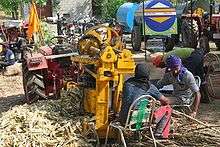

Vaisakhi is a harvest festival for people of the Punjab region.[38] In the Punjab, Vaisakhi marks the ripening of the rabi harvest.[39] Vaisakhi also marks the Punjabi new year.[40] This day is observed as a thanksgiving day by farmers whereby farmers pay their tribute, thanking God for the abundant harvest and also praying for future prosperity.[41] The harvest festival is celebrated by Sikhs and Punjabi Hindus.[42] Historically, during the early 20th century, Vaisakhi was a sacred day for Sikhs and Hindus and a secular festival for all Muslims and non-Muslims including Punjabi Christians.[43] In modern times, sometimes Christians participate in Baisakhi celebrations along with Sikhs and Hindus.[44]
Aawat pauni
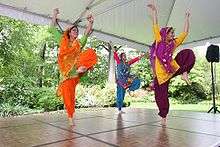
Aawat pauni is a tradition associated with harvesting, which involves people getting together to harvest the wheat. Drums are played while people work. At the end of the day, people sing dohay to the tunes of the drum.[45]
Fairs and dances
The harvest festival is also characterized by the folk dance, Bhangra which traditionally is a harvest dance.
Fairs or Melas (fair) are held in many parts of Punjab, India to mark the new year and the harvesting season. Vaisakhi fairs take place in various places, including Jammu City, Kathua, Udhampur, Reasi and Samba,[46] in the Pinjore complex near Chandigarh,[47] in Himachal Pradesh cities of Rewalsar, Shimla, Mandi and Prashar Lakes.
Hinduism
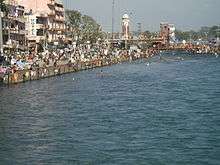
The first day of Vaisakh marks the traditional solar new year[48][49] and it is an ancient festival that predates the founding of Sikhism. The harvest is complete and crops ready to sell, representing a time of plenty for the farmers. Fairs and special thanksgiving pujas (prayers) are common in the Hindu tradition.[50]
The first day of Vaisakh marks the solar new year.[51] It is the New Year's Day for Hindus in Assam, Bengal, Bihar, Himachal Pradesh, Haryana, Kerala, Odisha, Punjab[52] Tamil Nadu, Uttar Pradesh, Uttrakhand and other parts of India.[51][20] However, this is not the universal new year for all Hindus. For some, such as those in and near Gujarat, the new year festivities coincide with the five-day Diwali festival.[20] For others, the new year falls on Cheti Chand, Gudi Padwa and Ugadi which falls a few weeks earlier.[20][53]
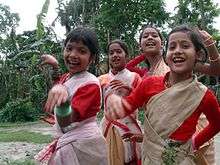
It is regionally known by many names among the Hindus, though the festivities and its significance is similar. It is celebrated by Hindus bathing in sacred rivers, as they believe that river goddess Ganges descended to earth on Vaisakhi from Svarga.[50][54] Some rivers considered particularly sacred include the Ganges, Jhelum and Kaveri. Hindus visit temples, meet friends and party over festive foods.[18]
Vaisakhi coincides with the festival of 'Vishu' and 'Puthandu' celebrated in Kerala and Tamilnadu a day after Vaisakhi. The festivities include fireworks, shopping for new clothes and interesting displays called 'Vishu Kani'. Hindus make arrangements of flowers, grains, fruits which friends and family visit to admire as "lucky sight" (Vishukkani). Giving gifts to friends and loved ones, as well as alms to the needy, are a tradition of Kerala Hindus on this festive day.[18]
Vaisakhi is celebrated as Bohag (Rongali) Bihu in Assam and as Pohela Boishakh in Bengal, but typically one or two days after Vaisakhi.[55]
Regional variations
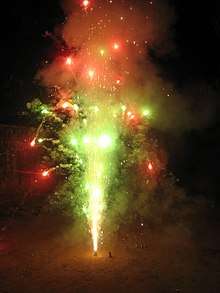
The following is a list of new year festivals:[51][56][20]
- Bikhu or Bikhauti in the Kumaon region of Uttarakhand, India
- Bisu – Tulu New Year Day amongst the Tulu people in India
- Bohag Bihu in Assam, India
- Edmyaar 1 (Bisu Changrandi) – Kodava New Year.
- JurShital (New Year) in Mithila (parts of Nepal and Bihar, India)
- Maha Vishuva Sankranti (or Pana Sankranti) in Odisha, India
- Naba Barsha or Pohela Boishakh in West Bengal and Tripura, India, Nepal and Bangladesh
- Puthandu in Tamil Nadu, India
- Ugadi in Andhra Pradesh, Karnataka and Telangana, India
- Vishu in Kerala, India
The new year falls on or about the same day every year for many Buddhist communities in parts of South and Southeast Asia. This is likely an influence of their shared culture in the 1st millennium CE.[20] Some examples include:
Bikhoti festival
The Bikhoti Festival of Uttrakhand involves people taking a dip in holy rivers. A popular custom involves beating symbolic stones representing demons with sticks. The fair is celebrated in various major centres including Sealdah, Bageshwar and Dwarahat and involves much singing and dancing, accompanied by local drums and other instruments.[58]
Vishu
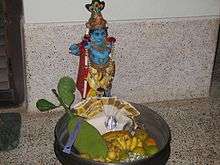
Vishu is a Hindu festival celebrated on the same day as Vaisakhi in the Indian state of Kerala, and falls on the first day of Malayali month called Medam.[59][60] The festival is notable for its solemnity and the general lack of pomp and show that characterize other Hindu festivals of Kerala such as Onam.[59][61]
The festival is marked by family time, preparing colorful auspicious items and viewing these as the first thing on the Vishu day. In particular, Malayali Hindus seek to view the golden blossoms of the Indian laburnum (Kani Konna), money or silver items (Vishukkaineetam), and rice.[59][61] The day also attracts firework play by children,[59][62] wearing new clothes (Puthukodi) and the eating a special meal called Sadya, which is a mix of salty, sweet, sour and bitter items.[63] The Vishu arrangement typically includes an image of Vishnu, typically as Krishna. People also visit temples on the day.[64]
Bohag Bihu
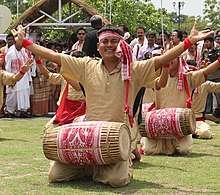
Bohag Bihu or Rangali Bihu marks the beginning of the Assamese New Year on 13 April. It is celebrated for seven days Vishuva Sankranti (Mesha Sankranti) of the month of Vaisakh or locally 'Bohag' (Bhaskar Calendar). The three primary types of Bihu are Rongali Bihu, Kongali Bihu, and Bhogali Bihu. Each festival historically recognizes a different agricultural cycle of the paddy crops. During Rangali Bihu there are 7 pinnacle phases: 'Chot', 'Raati', 'Goru', 'Manuh', 'Kutum', 'Mela' and 'Chera'.[65]
Maha Vishuva Sankranti
Maha Vishuva Sankranti marks the Oriya new year in Odisha. Celebrations include various types of folk and classical dances, such as the Shiva-related Chhau dance.[66] More popularly it is known as Pana Sankranti (ପଣା ସଂକ୍ରାନ୍ତି). On this day people hang pieces of Neem branches with leaves in front of their houses believed to have health benefits. They prepare a liquid mixture of jaggery, mango, pepper and other ingredients which is called Pana(ପଣା). An earthen pot with a small hole and a grass(କୁୁଶ) within the hole at the bottom is hung over the Tulasi (ତୁୁୁଳସୀ ଚଉରା). The pot is filled with water daily which acts as a drip to protect the sacred plant from the summer heat.[67]
Pahela Baishakh
The Bengali new year is celebrated as Pahela Baishakh on 14 April every year, and a festive Mangal Shobhajatra, started by students of Dhaka University in Bangladesh in 1989,[68] is organized in the Indian states of West Bengal and Tripura, as well as modern-day nation of Bangladesh. This celebration was listed in 2016 by the UNESCO as a cultural heritage of humanity.[69][70]
The festival is celebrated as a national holiday in Bangladesh. Also spelled Pohela Boishakh is also known as Nobo Barsho as it is the first day of the Bengali month of Bongabdo. Fairs are organised to celebrate the event which provides entertainment including the presentation of folk songs.[71]
Puthandu
Puthandu, also known as Puthuvarusham or Tamil New Year, is the first day of the month Chithirai on the Tamil calendar.[72][73][57]
On this day, Tamil people greet each other by saying "Puttāṇṭu vāḻttukkaḷ!" or "Iṉiya puttāṇṭu nalvāḻttukkaḷ!", which is equivalent to "Happy new year".[74] The day is observed as a family time. Households clean up the house, prepare a tray with fruits, flowers and auspicious items, light up the family Puja altar and visit their local temples. People wear new clothes and youngster go to elders to pay respects and seek their blessings, then the family sits down to a vegetarian feast.[75]
Sikh celebrations outside India
Pakistan
Pakistan has many sites that are of historic importance to the Sikh faith, such as the birthplace of Guru Nanak. These sites attract pilgrims from India and abroad every year on Vaisakhi.[78][79] Pakistan used to have many more Sikhs, but a vast majority moved to India during the 1947 India-Pakistan partition. Contemporary Pakistan has about 20,000 Sikhs in a total population of about 200 million Pakistanis, or about 0.01%.[80] These Sikhs, and thousands more who arrive from other parts of the world for pilgrimage, observe Vaisakhi in Western Punjab (Pakistan) with festivities centered on the Panja Sahib complex in Hasan Abdal, Gurudwaras in Nankana Sahib, and in various historical sites in Lahore.[81][note 1]
According to Aziz-ud-din Ahmed, Lahore used to have Baisakhi Mela after the harvesting of the wheat crop in April. However, adds Ahmed, the city started losing its cultural vibrancy in 1970s after Zia-ul-Haq came to power, and in recent years "the Pakistan Muslim League (N) government in Punjab banned kite flying through an official edict more under the pressure of those who want a puritanical version of Islam to be practiced in the name of religion than anything else".[85] Unlike the Indian state of Punjab that recognizes the Vaisakhi Sikh festival as an official holiday,[86] the festival is not an official holiday in Punjab or Sindh provinces of Pakistan as Sikhs constitute a very small number in terms of population.[87][88]
Canada
In the Province of British Columbia, large, local Sikh communities in the cities of Vancouver, Abbotsford, and Surrey hold their annual Vaisakhi celebrations in April,[89] which include two Nagar Kirtan (parades). The Vancouver parade starts at Ross Street Temple[90] and makes its way through the traditional Punjabi Market in South Vancouver.[91] One week later, the festival in Surrey is one of the largest such celebrations outside of India, having attracted over 200,000 people in 2014,[92] over 350,000 in 2015, and approached 400,000 in 2016. The 2017 attendance in Surrey reportedly topped 400,000, causing organizers to consider future distribution of the festival over several days and local cities, particularly in areas of economic disadvantage which would benefit from the generous charitable efforts seen during Vaisakhi celebrations.[93][94] Record attendance was again experienced in April 2018 in the 20th annual Surrey Vaisakhi parade, with the RCMP officially estimating the crowd at over half a million people in a city with a 2016 census population of 517,887.[95] Starting at the Gurdwara Dashmesh Darbar Temple (12885 85th Avenue in Surrey), the parade features a variety of floats, community groups, free food, live music and dancers and performers, and travels along 124th Street, turns left onto 75th Avenue, continues on 76th Avenue, onto 128th Street, then back to the Temple.[96] Kelowna's annual Vaisakhi parade is held a week after Surrey's parade each year and begins and ends at the Sikh Temple on Rutland Road.[97] Victoria's all-day Vaisakhi celebration features a parade that begins and ends at Gurdwara Singh Sabha, 470 Cecelia Road. The 2018 celebrations on 29 April would be the first held in Victoria in over 100 years.[98]
In the Province of Alberta, the Edmonton Vaisakhi parade is held in May and travels between the Gurdwara Singh Sabha (4504 Millwoods Road S) & Gurdwara Millwoods (2606 Millwoods Road E) temples.[99]
In the Province of Nova Scotia, the Halifax-based Maritime Sikh Society holds Vaisakhi celebrations in April featuring Shabad Kirtan performed by professional ragis (musicians).[100]
In the Province of Ontario, the Toronto Vaisakhi Parade is held in April, starting at the Canadian National Exhibition grounds and traveling east to Toronto City Hall, finishing almost three hours later. Following the parade, dignitaries address the gathering until late afternoon.[101] In the city of Malton, a three-hour Nagar Kirtan parade winds from Morning Star, Goreway, Derry Rd, & Airport Rd to Malton Gurdwara Sahib. In the city of Brampton, the Gurudwara Sikh Sangat temple and Gobind Sarvar Gurmat School hold Vaisakhi cultural events such as yoga, pagh (turban) tying, storytelling, and food fairs.[102]
In the Province of Saskatchewan, the Saskatoon Vaisakhi parade is held in May, starting and ending at the Gurudwara Sahib Temple at 331 Lowe Road.[103]
United Kingdom
The United Kingdom has a large Sikh community originating from the Indian sub-continent, East Africa[104] and Afghanistan. The largest concentrations of Sikhs in the UK are to be found in the West Midlands (especially Birmingham and Wolverhampton) and London.[105] The Southall Nagar Kirtan is held on a Sunday a week or two before Vaisakhi. The Birmingham Nagar Kirtan is held in late April in association with Birmingham City Council,[106] and is an annual event attracting thousands of people which commences with two separate nagar kirtans setting off from gurdwaras in the city and culminating in the Vaisakhi Mela at Handsworth Park.[107]
United States
Amongst Sikh populations in the United States, there is usually a parade commemorating the Vaisakhi celebration. In Manhattan, New York City[108] people come out to do "Seva" (selfless service) such as giving out free food, and completing any other labor that needs to be done. In Los Angeles, California, the local Sikh community consisting of many gurdwaras[109] holds a full day Kirtan (spiritual music) program followed by a parade.
Malaysia
The Sikh community, a subgroup of the Malaysian Indian ethnic minority race, is an ethnoreligious minority in Malaysia, which is why Vaisakhi is not a public holiday. However, in line with the government's efforts to promote integration among the country's different ethnic and religious groups, the prime minister, Najib Razak has announced that beginning 2013, all government servants from the Sikh Malaysian Indian community will be given a day off on Vaisakhi Day.[110] Vaisakhi 'open houses' are also held across the country during the day of the festival, or the closest weekend to it.
Notes
- On 8 April 2016, Punjabi Parchar at Alhamra (Lahore) organised a show called Visakhi mela, where the speakers pledged to "continue our struggle to keep the Punjabi culture alive" in Pakistan through events such as Visakhi Mela.[82] Elsewhere Besakhi fairs or melas are held in various places including Eminabad[83] and Dera Ghazi Khan.[84]
References
- Cath Senker (2007). My Sikh Year. The Rosen Publishing Group. p. 10. ISBN 978-1-4042-3733-9., At Vaisakhi, Sikhs remember how their community, the Khalsa, first began."
- William Owen Cole; Piara Singh Sambhi (1995). The Sikhs: Their Religious Beliefs and Practices. Sussex Academic Press. p. 63. ISBN 978-1-898723-13-4., Quote: "The Sikh new year, Vaisakhi, occurs at Sangrand in April, usually on the thirteenth day."
- "April 2019 Official Central Government Holiday Calendar". Government of India. Retrieved 17 December 2017.
- "April 2020 Official Central Government Holiday Calendar". Government of India. Retrieved 17 December 2017.
- Harjinder Singh. Vaisakhi. Akaal Publishers. p. 2.
- K.R. Gupta; Amita Gupta (2006). Concise Encyclopaedia of India. Atlantic Publishers. p. 998. ISBN 978-81-269-0639-0.
- Bodiwala, Suresh (18 November 2017). "Sikh Religious Society Organizes Two -day Conference in Chicago to Implement Mool Nanakshahi Calendar". Chicago Tribune. Archived from the original on 20 November 2017.
- Harbans Singh (1 January 1998). The Encyclopaedia of Sikhism: S-Z. Publications Bureau. ISBN 978-81-7380-530-1.
- BBC Religions (2009), Vaisakhi and the Khalsa
- Knut A. Jacobsen (2008). South Asian Religions on Display: Religious Processions in South Asia and in the Diaspora. Routledge. p. 192. ISBN 978-1-134-07459-4., Quote: "Vaisakhi is also a Hindu festival, but for the Sikhs, it celebrates the foundation of the Khalsa in 1699."
- S. R. Bakshi, Sita Ram Sharma, S. Gajnani (1998) Parkash Singh Badal: Chief Minister of Punjab. APH Publishing pages 208–209
- William Owen Cole; Piara Singh Sambhi (1995). The Sikhs: Their Religious Beliefs and Practices. Sussex Academic Press. pp. 135–136. ISBN 978-1-898723-13-4.
- Seiple, Chris (2013). The Routledge handbook of religion and security. New York: Routledge. p. 96. ISBN 978-0-415-66744-9.
- Harkirat S. Hansra (2007). Liberty at Stake, Sikhs: the Most Visible. iUniverse. pp. 28–29. ISBN 978-0-595-43222-6.
- The Encyclopaedia of Sikhism Archived 8 May 2014 at the Wayback Machine, section Sāhib Siṅgh Bedī, Bābā (1756–1834).
- Jonathan H. X. Lee; Kathleen M. Nadeau (2011). Encyclopedia of Asian American Folklore and Folklife. ABC-CLIO. pp. 1012–1013. ISBN 978-0-313-35066-5.
- Christian Roy (2005). Traditional Festivals: A Multicultural Encyclopedia. ABC-CLIO. pp. 479–480. ISBN 978-1-57607-089-5.
- Crump, William D. (2014), Encyclopedia of New Year's Holidays Worldwide, MacFarland, page 114
- Karen Pechilis; Selva J. Raj (2013). South Asian Religions: Tradition and Today. Routledge. pp. 48–49. ISBN 978-0-415-44851-2.
- "Archived copy". Archived from the original on 4 March 2016. Retrieved 26 November 2014.CS1 maint: archived copy as title (link)
- "Pronunciation of Vaisakhi".
- Pashaura Singh (2005), Understanding the Martyrdom of Guru Arjan, Journal of Punjab Studies, 12(1), pages 29–62
- Johar, Surinder (1999). Guru Gobind Singh: A Multi-faceted Personality. M.D. Publications. p. 89. ISBN 978-8175330931.
- Singh Gandhi, Surjit (2008). History of Sikh Gurus Retold: 1606 -1708. Atlantic Publishers. pp. 676–677. ISBN 8126908572.
- Laws of the State of Illinois Enacted by the ... General Assembly at the Extra Session. (2013) State Printers. page 7772
- Singh, Jagraj (2009) A Complete Guide to Sikhism. Unistar Books page 311
- Purewal, Pal. "Vaisakhi Dates Range According To Indian Ephemeris By Swamikannu Pillai – i.e. English Date on 1 Vaisakh Bikrami" (PDF). www.purewal.biz. Retrieved 13 April 2016.
- Kaur, Madanjit (2007). Unistar Books Guru Gobind Singh: Historical and Ideological Perspective, page 149
- W. H. McLeod (2009). The A to Z of Sikhism. Scarecrow Press. pp. 143–144. ISBN 978-0-8108-6344-6.
- Tribune News service (14 April 2009). "Vaisakhi celebrated with fervour, gaiety". The Tribune, Chandigarh.
- Dogra, Ramesh Chander and Dogra, Urmila (2003) Page 248 The Sikh World: An Encyclopedic Survey of Sikh Religion and Culture. UBS Publishers Distributors Pvt Ltd ISBN 81-7476-443-7
- The Panjab in 1839–40: selections from the Punjab akhbars, Punjab intelligence, etc., preserved in the National Archives of India, New Delhi (1952) Sikh History Society
- Nick Hunter (2016). Celebrating Sikh Festivals. Raintree. p. 10. ISBN 978-1-4062-9776-8.
- Brown, Alan (1986). "Festivals in World Religions". Longman. Retrieved 14 September 2016 – via Google Books.
- Simon J Bronner (2015), Routledge Encyclopedia of American Folklife, page 1132
- Kapel, Marin (2006) The Structure and Mathematics of the Principal Calendars of the Western World: Muslim, Gregorian, Jewish, and Other Systems. Edwin Mellen Press
- Bakshi, S. R. Sharma, Sita Ram (1998) Parkash Singh Badal: Chief Minister of Punjab
- Dogra, Ramesh Chander and Dogra, Urmila (2003) Page 49 The Sikh World: An Encyclopedic Survey of Sikh Religion and Culture. UBS Publishers Distributors Pvt Ltd ISBN 81-7476-443-7
- Sainik Samachar: The Pictorial Weekly of the Armed Forces, Volume 33 (1986) Director of Public Relations, Ministry of Defence,
- Dhillon, (2015) Janamsakhis: Ageless Stories, Timeless Values. Hay House
- Gupta, Surendra K. (1999) Indians in Thailand, Books India International
- "Link: Indian Newsmagazine". 13 April 1987 – via Google Books.
- Nahar, Emanual (2007) Minority politics in India: role and impact of Christians in Punjab politics. Arun Pub. House.
- Dr Singh, Sadhu (2010) Punjabi Boli Di Virasat. Chetna Prakashan. ISBN 817883618-1
- "Baisakhi celebrated with fervour, gaiety in J&K". 14 April 2015. Retrieved 14 September 2016.
- Punia, Bijender K. (1 January 1994). "Tourism Management: Problems and Prospects". APH Publishing. Retrieved 14 September 2016 – via Google Books.
- Rao, S. Balachandra (1 January 2000). "Indian Astronomy: An Introduction". Universities Press. Retrieved 14 September 2016 – via Google Books.
- Tribune 15 April 2011 Baisakhi fervour at Haridwar Lakhs take dip in holy Ganga
- Robin Rinehart (2004). Contemporary Hinduism: Ritual, Culture, and Practice. ABC-CLIO. p. 139. ISBN 978-1-57607-905-8.
- "BBC – Religion: Hinduism – Vaisakhi". BBC. Retrieved 22 January 2012.
- Crump, William D. (2014) Encyclopedia of New Year's Holidays Worldwide. McFarland
- Mark-Anthony Falzon (2004). Cosmopolitan Connections: The Sindhi Diaspora, 1860–2000. BRILL. p. 62. ISBN 90-04-14008-5.
- Lochtefeld, James G. (1 January 2002). "The Illustrated Encyclopedia of Hinduism: A-M". The Rosen Publishing Group. Retrieved 14 September 2016 – via Google Books.
- "2017 Official Central Government Holiday Calendar" (PDF). Government of India. Retrieved 4 March 2017.
- Crump, William D. (2014), Encyclopedia of New Year's Holidays Worldwide, MacFarland, page 114
- Peter Reeves (2014). The Encyclopedia of the Sri Lankan Diaspora. Didier Millet. p. 174. ISBN 978-981-4260-83-1.
- "Festivals and Culture".
- Major festivals of Kerala, Government of Kerala (2016)
- J. Gordon Melton (2011). Religious Celebrations: An Encyclopedia of Holidays, Festivals, Solemn Observances, and Spiritual Commemorations. ABC-CLIO. p. 633. ISBN 978-1-59884-206-7.
- Maithily Jagannathan (2005). South Indian Hindu Festivals and Traditions. Abhinav Publications. pp. 76–77. ISBN 978-81-7017-415-8.
- "City celebrates Vishu". The Hindu. 16 April 2010. Retrieved 27 September 2013.
- "When the Laburnum blooms". The Hindu. 14 April 2011. Retrieved 27 September 2013.
- Roshen Dalal (2010). Hinduism: An Alphabetical Guide. Penguin Books. p. 461. ISBN 978-0-14-341421-6.
- "Bohag Bihu". Britannica.
- Sitakant Mahapatra (1993). Chhau Dance of Mayurbhanj. Vidyapuri. p. 86.
- "Odisha celebrates New Year Maha Vishuva Sankranti". The Hindu.
- "'Mongol Shobhajatra' parades city streets". The Financial Express Online Version. Retrieved 16 April 2017.
- Mangal Shobhajatra on Pahela Baishakh, UNESCO
- "Unesco lists Mangal Shobhajatra as cultural heritage". The Daily Star. 1 December 2016. Retrieved 16 April 2017.
- "Pahela Baishakh celebrated". The daily star.
- Roshen Dalal (2010). Hinduism: An Alphabetical Guide. Penguin Books. p. 406. ISBN 978-0-14-341421-6.
- J. Gordon Melton (2011). Religious Celebrations: An Encyclopedia of Holidays, Festivals, Solemn Observances, and Spiritual Commemorations. ABC-CLIO. p. 633. ISBN 978-1-59884-206-7.
- William D. Crump (2014). Encyclopedia of New Year's Holidays Worldwide. McFarland. p. 220. ISBN 978-0-7864-9545-0.
- Samuel S. Dhoraisingam (2006). Peranakan Indians of Singapore and Melaka. Institute of Southeast Asian Studies. p. 38. ISBN 978-981-230-346-2.
- Hari Bansh Jha (1993) The terai community and national integration in Nepal.
- "Ethnobotany". Aavishkar Publishers, Distributors. 1 January 2002 – via Google Books.
- Glare and galore at Baisakhi festival, The Dawn, Pakistan (15 April 2015)
- Vaisakhi 2015: Sikh devotees celebrate major festival in India and Pakistan, David Sims, International Business Times
- Ary News 17 April 2015 Sikh pligrims gather in Pakistan for Vaisakhi festival
- Muhammad Najeeb Hasan Abdal (12 April 2008). "Sikh throng Pakistan shrine for Vaisakhi". Thaindian News. www.thaindian.com. Retrieved 22 January 2012.
- Pakistan Today (8 April 2016) Punjabi Parchar spreads colours of love at Visakhi Mela
- "A fair dedicated to animal lovers". DAWN.COM. 20 April 2009.
- Agnes Ziegler, Akhtar Mummunka (2006) The final Frontier: unique photographs of Pakistan. Sang-e-Meel Publications
- Cultural Decline in Pakistan, Pakistan Today, Aziz-ud-din Ahmed (21 February 2015)
- Official Holidays, Government of Punjab, India (2016)
- Official Holidays 2016, Government of Punjab – Pakistan (2016)
- Official Holidays 2016, Karachi Metropolitan, Sindh, Pakistan
- Global News 12 April 2015 Vaisakhi celebrated at parade in south Vancouver
- "Khalsa Diwan Society | Vancouver".
- "Thousands brighten Vancouver streets to mark Vaisakhi". CBC News. Retrieved 24 April 2018.
- VancouverDesi.com 14 April 2015 What you need to know about the Vaisakhi parade
- "Surrey's Vaisakhi parade draws record attendance in massive celebration of diversity and inclusion". Vancouver Sun. Retrieved 21 April 2017.
- "Up to 400K people expected to attend 2017 Surrey Vaisakhi parade". CBC News. Retrieved 21 April 2017.
- "Surrey's Vaisakhi parade biggest ever". North Delta Reporter. Retrieved 24 April 2018.
- "Surrey Vaisakhi Parade Map". Retrieved 24 April 2018.
- "Vaisakhi Parade Saturday". Castanet. Retrieved 25 April 2018.
- "After 100 years, Vaisakhi returns to Victoria". CBC. Retrieved 28 April 2018.
- "Vaisakhi 2018". Retrieved 24 April 2018.
- "Maritime Sikh Society – About Us". Retrieved 28 April 2018.
- "Khalsa Day Parade Celebrate the founding of the Sikh community. at Better Living Centre". Retrieved 24 April 2018.
- "Vaisakhi Cultural Food Fair". Retrieved 24 April 2018.
- "1st-ever Saskatoon Sikh Parade was so busy it spurred a traffic advisory". Retrieved 28 April 2018.
- S. K. Rait (2005) Sikh Women in England: Their Religious and Cultural Beliefs and Social Practices
- Amarjeet Singh (2014) Indian Diaspora: Voices of Grandparents and Grandparenting
- Council, Birmingham City. "Things to do – Birmingham City Council". Retrieved 14 September 2016.
- "Thousands join Sikh Vaisakhi celebrations in Birmingham". BBC News. 22 April 2012. Retrieved 10 May 2012.
- "Annual NYC Sikh Day Parade". www.nycsikhdayparade.com. 30 April 2012. Archived from the original on 22 March 2012. Retrieved 22 January 2012.
- "Baisakhi – Guru Ram Das Ashram". Retrieved 14 September 2016.
- "Sikh civil servants get Vaisakhi holiday". The Star Online. 8 May 2012. Retrieved 15 February 2013.


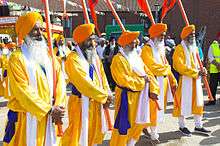

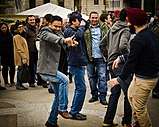






.jpg)
.jpg)


